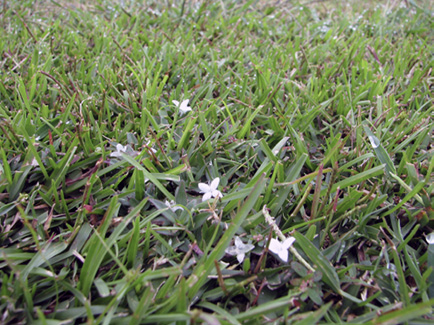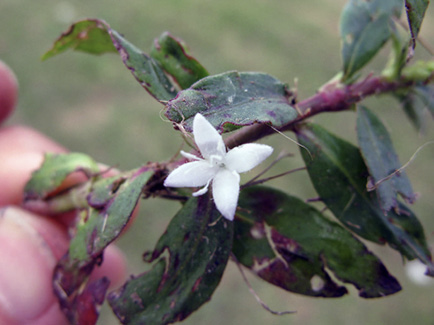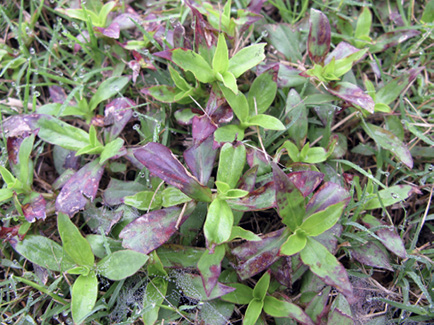Virginia Buttonweed Control
Virginia buttonweed (Diodia virginiana L.) is a troublesome turfgrass weed throughout the state of Mississippi and in the surrounding southeastern states. It is a spreading, perennial broadleaf that reproduces by seed, fleshy roots, and stem fragments. It has opposite, lance-shaped leaves that produce small, four-lobed, white flowers (Figures 1 and 2) that mature into small, elliptical-shaped seed pods. Purple leaves during late spring to early summer emergence are a distinguishing characteristic of this particular weed (Figure 3).



Virginia buttonweed favors moist to wet areas but can become a nuisance throughout a lawn. The plant spreads outward in a mat and rarely grows much taller than normal turfgrass mowing heights. Because it can reproduce vegetatively and through seed distribution within the thatch layer, preemergence herbicides provide only fair control. For this reason, combining cultural controls with postemergence herbicides is the most effective means of management.
Cultural Prevention
As with most weeds, Virginia buttonweed is especially problematic in poor turf stands. Improving stand density of turfgrass can be helpful; however, excess fertilization and moisture may contribute to the increased invasiveness of this pest. A brief guide to nutrient and moisture management for turfgrass can be found in MSU Extension Publication 1322 Establish and Manage Your Home Lawn.
Herbicide Recommendations
Premixed products containing phenoxy herbicides, such as 2,4-D, mecoprop, and dicamba (Trimec, Speedzone, Spotlight, Weed B Gon, etc.), are effective if applied several times during the growing season. These “broadleaf”-specific herbicides are most often available for homeowners at local lawn and garden stores. Commercial applicators may find that the phenoxy-type herbicide fluroxypyr and equivalent mixtures (e.g., Escalade 2) provide better control than those previously mentioned.
The sulfonylurea herbicides, such as chlorsulfuron, metsulfuron, and trifloxysulfuron, are also very effective at extremely low use rates. In trials at Mississippi State University, metsulfuron-methyl (MSM-Turf or Manor) and flazasulfuron (Katana) have provided good to excellent control of Virginia buttonweed as well as white clover (Trifolium repens). Commercial applicators may find that products such as Celsius (containing thiencarbazone and iodosulufron, in addition to dicamba) provide better control of a range of broadleaf weeds, in addition to Virginia buttonweed.
Be sure to properly calibrate application equipment and apply herbicides accurately to prevent turf and landscape injury. Read product labels carefully and completely, as not all products can be applied to all warm-season turf species. More specific information on controlling weeds in home lawns can be found in the turf section of MSU Extension Publication 1532 Weed Control Guidelines for Mississippi.
|
Turfgrass Species Use Recommendation |
|||||||
|---|---|---|---|---|---|---|---|
|
Herbicide |
Bermudagrass |
Carpetgrass |
Centipedegrass |
St. Augustinegrass |
Zoysiagrass |
Tall Fescue |
Expected Virginia Buttonweed Control |
|
2,4-D |
Yes |
No |
No |
No |
Yes |
Yes |
Fair |
|
Blindside |
Yes |
No |
Yes |
Yes |
Yes |
Yes |
Excellent |
|
Celsius |
Yes |
No |
Yes |
Yes |
Yes |
No |
Good |
|
Celsius XTRA |
Yes |
No |
Yes |
Yes |
Yes |
No |
Good |
|
Change-Up |
Yes |
Yes |
Yes |
Yes |
Yes |
Yes |
Excellent |
|
Dicamba |
Yes |
No |
No |
No |
Yes |
Yes |
Good |
|
Escalade 2 |
Yes |
No |
No |
No |
Yes |
Yes |
Excellent |
|
Monument |
Yes |
No |
No |
No |
Yes |
No |
Excellent |
|
MSM-Turf or Manor |
Yes |
No |
Yes |
Yes |
Yes |
No |
Good |
|
Recognition |
Yes |
No |
No |
Yes |
Yes |
No |
Good |
|
Speedzone Southern |
Yes |
No |
No |
No |
Yes |
Yes |
Good |
|
Trimec or Vessel |
Yes |
No |
No |
No |
Yes |
Yes |
Good |
|
Trimec Southern |
Yes |
No |
No |
No |
Yes |
Yes |
Good |
Publication 3672 (POD-07-24)
By Jay McCurdy, PhD, Associate Professor, Plant and Soil Sciences.
The Mississippi State University Extension Service is working to ensure all web content is accessible to all users. If you need assistance accessing any of our content, please email the webteam or call 662-325-2262.





